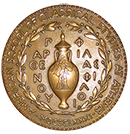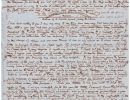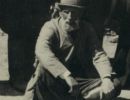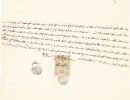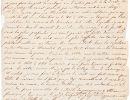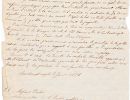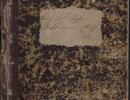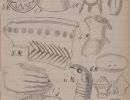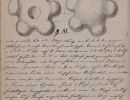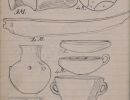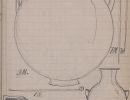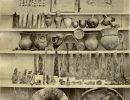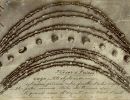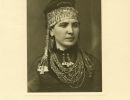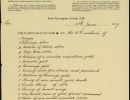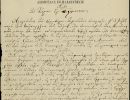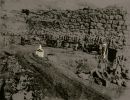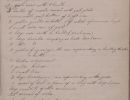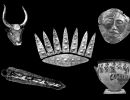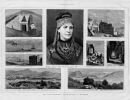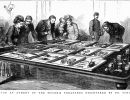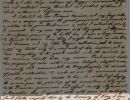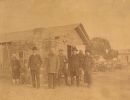The discovery of Troy (1870-1873) was among Schliemann’s greatest accomplishments, the first to bring him international fame and recognition in scholarly circles. Troy remained his passion; he never abandoned the site, leading his final field season at Hissarlik in 1890, the year he died. The Ottoman authorities issued the excavation permit for Troy in August 1871. During the 1873 campaign unique finds began to appear, including the so-called “Treasure of Priam.” The Trojan finds were exhibited for three years in London (1877-1880), but in 1881, Schliemann bequeathed them to Germany; they were exhibited at the Museum of Decorative Arts (Kunstgewerbemuseum) in Berlin. When Berlin fell to the Soviet forces in 1945, the “Treasure” was taken to Russia and is currently kept at the Pushkin Museum in Moscow.
Schliemann’s excavations at Mycenae (1876) revealed the riches of another prehistoric civilization that to him confirmed its link with Homer. The Shaft Graves yielded a wealth of finds: from golden diadems, cups, and seal rings to bronze weaponry, and golden masks, including the “Mask of ‘Agamemnon’,” as he called it. Unlike the artifacts from Troy, the Mycenae finds never left the land of their discovery and are on permanent exhibit at the National Archaeological Museum in Athens.
Schliemann continued to search for Homeric sites, uncovering a tholos tomb at Orchomenos in Boeotia (1881, 1886), and another Mycenaean palace at Tiryns in the Argolid (1884). Wilhelm Dörpfeld, architect of the German excavations at Olympia was by his side at Tiryns. Having already assisted at Troy in 1882, he became director of the Troy excavations after Schliemann’s death.
-
4.1.1
Frank Calvert (1828–1908) had served for many years as U.S. Consul at the Dardanelles and was the owner of land at Hissarlik. The two men met in 1868 at Troy; it was Calvert who directed Schliemann to target his efforts on the hill of Hissarlik. Frank Calvert’s letter to Heinrich Schliemann of February 3, 1869. He includes a sketch of the hill of Hissarlik and the news that "a new law had been promulgated by which excavations have been prohibited."
ASCSA Archives, Heinrich Schliemann Papers
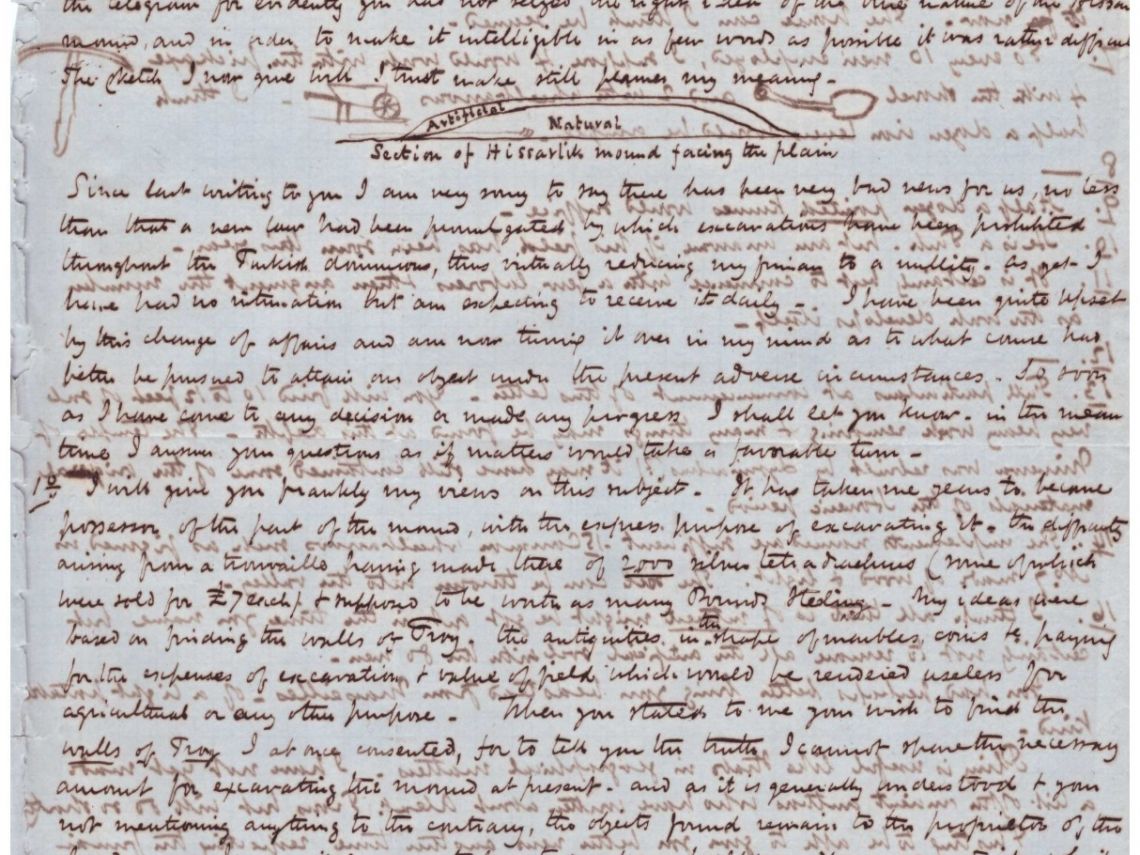
-
4.1.2
Frank Calvert (from a group photo), 1890
ASCSA Archives, Heinrich Schliemann Papers
-
4.2.1
Schliemann obtained the firman allowing him to excavate on the hill of Hissarlik in August 1871. It contains three distinct clauses: First, all finds had to be divided between the Ottoman authorities and the excavator. Second, uncovered ruins had to be left in the state in which they had been found. Lastly, all expenses were to be covered by Schliemann. He arrived at the site at the end of September 1871 and the excavation officially began October 11, 1871.
The firman for excavating Troy, issued on January 6, 1876
ASCSA Archives, Heinrich Schliemann Papers
-
4.2.2 seriesd box1 firman french a 1200px
The French translation of the firman for excavating Troy, issued on January 6, 1876.
ASCSA Archives, Heinrich Schliemann PapersPage 1 of 2

-
4.2.2 seriesd box1 firman french b 1200px
The French translation of the firman for excavating Troy issued on January 6, 1876.
ASCSA Archives, Heinrich Schliemann PapersPage 2 of 2

-
4.3.diary cover 1200px
Cover of Diary A14, where Schliemann penned: “Henry und Sophia Schliemanns Buch” (“1873” was added later).
ASCSA Archives, Heinrich Schliemann Papers
-
4.3.2 p.25 1200px
Diary A14 contains entries for the excavations at Troy from February 21 to June 17, 1873. In addition to Schliemann’s own observations and sketches, this diary also includes drawings by Greek painter Polychronis Lembesis, who had joined Schliemann in Troy.
Diary A14, page 25
ASCSA Archives, Heinrich Schliemann Papers
-
4.3.2. p.26 1200ox
Diary A14, page 26
ASCSA Archives, Heinrich Schliemann Papers
-
4.3.2 p.112 1200px
Diary A14, page 112
ASCSA Archives, Heinrich Schliemann Papers
-
4.3.2 p.113 1200px
Diary A14, page 113
ASCSA Archives, Heinrich Schliemann Papers
-
4.4.1b 1200px
For three years (1877–1880), the Troy finds were exhibited at the South Kensington Museum (now the Victoria and Albert Museum). The Museum’s Annual Report for the year 1878 reads as follows regarding the exhibit:
"…[the Trojan antiquities were] exhibited in 25 cases in the South Court, together with two pieces of sculptured marble, and a selection from 129 drawings and photographs illustrating the excavations which are shown on screens."
Photograph showing objects from “Priam’s Treasure,” Atlas des Antiquités Troyennes (Leipzig, 1874)
ASCSA Archives, Heinrich Schliemann Papers
-
4.4.1c 1200px
Photograph showing objects from “Priam’s Treasure,” Atlas des Antiquités Troyennes (Leipzig, 1874)
ASCSA Archives, Heinrich Schliemann Papers
-
4.4.2 cwb box 35 f3 sophia schliemann 1200px
Sophia wearing the diadem from “Priam’s Treasure”
ASCSA Archives, Carl Blegen Papers
-
4.5a
Letter from the South Kensington Museum, dated June 1879, confirming the receipt of a list of Trojan finds sent by Schliemann, apparently to be added to the ones already on display in the South Court.
ASCSA Archives, Heinrich Schliemann Papers
-
4.6
The permit to excavate Mycenae, dated March 29, 1874, signed by Ioannis Valassopoulos (1821-1888), the Minister of Education:
"... ἵνα ἀνασκάψητε τὰς Μυκήνας ὑπὸ μόνον τὸν ὅρον νὰ δημοσιεύσητε ὑμεῖς πρῶτον τὰς ἀνακαλύψεις, αἵτινας ἤθελον προέλθει ἐκ τῆς ἀνασκαφῆς" ["…you are granted the permission to excavate Mycenae by the Ministry under the only condition that you publish first the finds that may originate from the excavations…"]
ASCSA Archives, Heinrich Schliemann Papers
-
4.7.1 sophia and schliemann grave circlea001 1200px
Panoramic photo of the Mycenae excavations (Grave Circle A), 1876.
Schliemann, wearing a white hat, stands on the right in front of the wall, while Sophia is standing on the left
ASCSA Archives, Melas Family Photographic Collection
-
4.8.1 a15 0139 135 1200px
Schliemann listing the finds from Grave Circle A, including:
3 golden masks which covered the faces of the persons;
2 small gold vessels
3 handles of swords covered with gold plates
1 large vase with 2 handles (κάνθαρος)
1 golden helmetASCSA Archives, Heinrich Schliemann Papers, Diary A15

-
4.9
A selection of photos of Heinrich Schliemann’s discoveries at Mycenae in 1876, now on permanent display at the National Archaeological Museum, Athens.
ASCSA Archives, Alison Frantz Photographic Collection

-
4.10.1 schliemann graphic 1877
The Troy and Mycenae excavations brought Schliemann instant glory and fame. Major newspapers and journals published details of his excavations and interviews with him, along with sketches of the archaeological sites and finds.
The Graphic, January 20, 1877
ASCSA Archives, Heinrich Schliemann Papers
-
4.11.1
The finds from Mycenae were first stored at the National Bank of Greece and subsequently exhibited at the National Technical University of Athens (Πολυτεχνείο) on Odos Patision. The finds were transferred to the National Archaeological Museum in 1892-1893.
Illustration in The Graphic: “Exhibition at Athens of the Mycenae Treasures discovered by Dr. Schliemann”
ASCSA Archives, Heinrich Schliemann Papers
-
4.12 1200px
"I flatter myself that I have discovered a new world for archaeology"
Heinrich Schliemann to Charles Thomas Newton (1816-1894), British archaeologist and Keeper of Greek and Roman Antiquities at the British Museum (July 26, 1873)
ASCSA Archives, Heinrich Schliemann Papers
-
4.13.1 schliemann troy 1889 47
Heinrich Schliemann with visiting scholars at the Troy Conference in December 1889.
Left to right: Workman, Wilhelm Dörpfeld, Ernst Bötticher, Bernhard Steffen, Heinrich Schliemann, Workman, Georg Niemann
ASCSA Archives, Heinrich Schliemann Papers
Frank Calvert (1828–1908) had served for many years as U.S. Consul at the Dardanelles and was the owner of land at Hissarlik. The two men met in 1868 at Troy; it was Calvert who directed Schliemann to target his efforts on the hill of Hissarlik. Frank Calvert’s letter to Heinrich Schliemann of February 3, 1869. He includes a sketch of the hill of Hissarlik and the news that "a new law had been promulgated by which excavations have been prohibited."
ASCSA Archives, Heinrich Schliemann Papers
Frank Calvert (from a group photo), 1890
ASCSA Archives, Heinrich Schliemann Papers
Schliemann obtained the firman allowing him to excavate on the hill of Hissarlik in August 1871. It contains three distinct clauses: First, all finds had to be divided between the Ottoman authorities and the excavator. Second, uncovered ruins had to be left in the state in which they had been found. Lastly, all expenses were to be covered by Schliemann. He arrived at the site at the end of September 1871 and the excavation officially began October 11, 1871.
The firman for excavating Troy, issued on January 6, 1876
ASCSA Archives, Heinrich Schliemann Papers
The French translation of the firman for excavating Troy, issued on January 6, 1876.
ASCSA Archives, Heinrich Schliemann Papers
Page 1 of 2
The French translation of the firman for excavating Troy issued on January 6, 1876.
ASCSA Archives, Heinrich Schliemann Papers
Page 2 of 2
Cover of Diary A14, where Schliemann penned: “Henry und Sophia Schliemanns Buch” (“1873” was added later).
ASCSA Archives, Heinrich Schliemann Papers
Diary A14 contains entries for the excavations at Troy from February 21 to June 17, 1873. In addition to Schliemann’s own observations and sketches, this diary also includes drawings by Greek painter Polychronis Lembesis, who had joined Schliemann in Troy.
Diary A14, page 25
ASCSA Archives, Heinrich Schliemann Papers
Diary A14, page 26
ASCSA Archives, Heinrich Schliemann Papers
Diary A14, page 112
ASCSA Archives, Heinrich Schliemann Papers
Diary A14, page 113
ASCSA Archives, Heinrich Schliemann Papers
For three years (1877–1880), the Troy finds were exhibited at the South Kensington Museum (now the Victoria and Albert Museum). The Museum’s Annual Report for the year 1878 reads as follows regarding the exhibit:
"…[the Trojan antiquities were] exhibited in 25 cases in the South Court, together with two pieces of sculptured marble, and a selection from 129 drawings and photographs illustrating the excavations which are shown on screens."
Photograph showing objects from “Priam’s Treasure,” Atlas des Antiquités Troyennes (Leipzig, 1874)
ASCSA Archives, Heinrich Schliemann Papers
Photograph showing objects from “Priam’s Treasure,” Atlas des Antiquités Troyennes (Leipzig, 1874)
ASCSA Archives, Heinrich Schliemann Papers
Sophia wearing the diadem from “Priam’s Treasure”
ASCSA Archives, Carl Blegen Papers
Letter from the South Kensington Museum, dated June 1879, confirming the receipt of a list of Trojan finds sent by Schliemann, apparently to be added to the ones already on display in the South Court.
ASCSA Archives, Heinrich Schliemann Papers
The permit to excavate Mycenae, dated March 29, 1874, signed by Ioannis Valassopoulos (1821-1888), the Minister of Education:
"... ἵνα ἀνασκάψητε τὰς Μυκήνας ὑπὸ μόνον τὸν ὅρον νὰ δημοσιεύσητε ὑμεῖς πρῶτον τὰς ἀνακαλύψεις, αἵτινας ἤθελον προέλθει ἐκ τῆς ἀνασκαφῆς" ["…you are granted the permission to excavate Mycenae by the Ministry under the only condition that you publish first the finds that may originate from the excavations…"]
ASCSA Archives, Heinrich Schliemann Papers
Panoramic photo of the Mycenae excavations (Grave Circle A), 1876.
Schliemann, wearing a white hat, stands on the right in front of the wall, while Sophia is standing on the left
ASCSA Archives, Melas Family Photographic Collection
Schliemann listing the finds from Grave Circle A, including:
3 golden masks which covered the faces of the persons;
2 small gold vessels
3 handles of swords covered with gold plates
1 large vase with 2 handles (κάνθαρος)
1 golden helmet
ASCSA Archives, Heinrich Schliemann Papers, Diary A15
A selection of photos of Heinrich Schliemann’s discoveries at Mycenae in 1876, now on permanent display at the National Archaeological Museum, Athens.
ASCSA Archives, Alison Frantz Photographic Collection
The Troy and Mycenae excavations brought Schliemann instant glory and fame. Major newspapers and journals published details of his excavations and interviews with him, along with sketches of the archaeological sites and finds.
The Graphic, January 20, 1877
ASCSA Archives, Heinrich Schliemann Papers
The finds from Mycenae were first stored at the National Bank of Greece and subsequently exhibited at the National Technical University of Athens (Πολυτεχνείο) on Odos Patision. The finds were transferred to the National Archaeological Museum in 1892-1893.
Illustration in The Graphic: “Exhibition at Athens of the Mycenae Treasures discovered by Dr. Schliemann”
ASCSA Archives, Heinrich Schliemann Papers
"I flatter myself that I have discovered a new world for archaeology"
Heinrich Schliemann to Charles Thomas Newton (1816-1894), British archaeologist and Keeper of Greek and Roman Antiquities at the British Museum (July 26, 1873)
ASCSA Archives, Heinrich Schliemann Papers
Heinrich Schliemann with visiting scholars at the Troy Conference in December 1889.
Left to right: Workman, Wilhelm Dörpfeld, Ernst Bötticher, Bernhard Steffen, Heinrich Schliemann, Workman, Georg Niemann
ASCSA Archives, Heinrich Schliemann Papers
